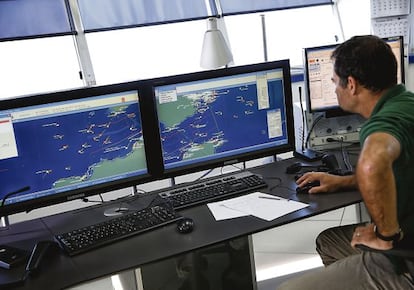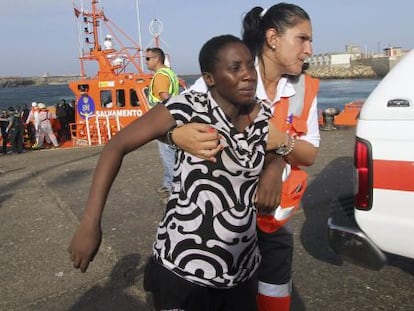The desperate trip to Parallel 35
This summer has seen a sharp increase in the number of migrants making the dangerous crossing from Morocco on board inflatable dinghies

Djambe and Dressi arrived in Spain a week apart, in mid-July. Like thousands of migrants before them, they rowed their way from Morocco across the Strait of Gibraltar in a fragile inflatable dinghy crammed with other hopefuls looking for a new life in Europe.
"We waited, hiding on the beach until four in the morning, then we inflated the boat and about 10 of us squeezed aboard," says Dressi. Their goal, although they didn't know it, was to cross parallel 35º 50', the point at which the Spanish authorities are responsible for maritime rescue, waters patrolled by a unit based in Tarifa, near the city of Cádiz. But the zone is so far south that some areas are closer to the Moroccan coast than that of Spain, says José Maraver of the Maritime Rescue Center in Tarifa.
"A lot of these dinghies call us from cellphones to say that they are drifting when they are still quite close to the Moroccan coastline. But if they have crossed the parallel they are our responsibility, not Morocco's," Maraver explains.
Dressi is 27 years old, and has spent the last two years of his life trying to get into Europe. He left his country - he won't say where he is from to avoid deportation - and for several days traveled by bus and on foot until he made it to the Moroccan border. The gangs that take migrants into Morocco left him in Casablanca. More usually, they take migrants by motorbike to Punta Almina, close to the Spanish enclave of Ceuta, and wait until it is dark, and then, using electric pumps, inflate tiny dinghies equipped only with oars, and send the migrants out to sea as quickly as possible.
The rescue center gets calls from migrants still close to Morocco's shore
"It took me six months to save the 300 euros they wanted from me to make the crossing," says Dressi about his first attempt to reach Spain, which was intercepted by the Moroccan coastguard. He was taken back to land and then transported by bus to the border with Algeria and told to return home.
Djambe's story is similar, except that he never even made it to sea: "The guy that took us to Casablanca asked for 160 euros each from 16 of us. Then he told us to meet him in Tangier, but we never saw him again."
It took Dressi and Djambe two more attempts as part of an odyssey that involved hiding aboard a train and living in the woods of Gurugú, outside Ceuta, which can be seen from Tarifa. On July 16, after a terrifying nine-hour trip at sea, Dressi spotted the orange-colored vessel of the Spanish maritime rescue service.
"We had been rowing for several hours, bailing out all the time. Two people were suffering from seasickness and had vomited; they had to do so in the boat, because if they leaned out, there was the risk the vessel would tip over... it was unbearable," he says. Everything changed when they finally spotted the Spanish maritime rescue.
"They are on the lookout for our boat, because they know that if we see them their nightmare is over," says captain Damián Malia, who has spent the last nine years working aboard the Salvamar Atria, part of the maritime rescue fleet. Based in Barbate, Cádiz, Malia and his crew, mechanic José Ramón Torres, and Juan Antonio Fernández, receive distress calls every day from dinghies adrift in the straits.

The distinctive orange boats are a powerful symbol of hope for the thousands of African migrants who cross the straits each year. "We give them blankets, coffee and energy biscuits, and even a special kit for shipwreck victims with clothes, sandals, and personal-hygiene products," says Torres. Malia, who says that he has lost count of the number of people he has plucked from the sea over the last decade, is nevertheless visibly affected when he talks about his experiences. "It breaks your heart to see these people, especially when there are children aboard, so small and with those huge, scared eyes, out there, lost at sea."
"Sometimes, when the sea is rough and there is a deep swell, even if you are close to the dinghies, you can't see them - you really have to keep a close watch," adds fellow crewman Fernández.
African migrants have been crossing from Morocco since the 1990s, but in recent years the numbers have declined, due in part to greater vigilance by the Moroccan authorities. But this summer has seen a sharp increase in the numbers of people coming into Tarifa: 80 percent on last year.
Helena Maleno, a volunteer at the Caminando Fronteras NGO, which has been working with African migrants holed up in Morocco waiting for their chance to cross, is highly critical of the Moroccan authorities. "The police are very violent. They stage raids on areas where there are Africans hiding out, and are extremely brutal; they respect nobody, not even people with passports and visas, or who have been granted refugee status. I have seen the injuries; there have been rapes and robberies as well," she says. Another NGO, Doctors Without Borders (DWB), has also highlighted systematic abuse by the Moroccan authorities. A recent report on the situation of African migrants in Morocco says that they are subject to institutionalized violence, and are prey to exploitation by criminal gangs.
"Now that it has toughened its border controls, Morocco has become not so much a transit point, but the only place to cross over, which makes these migrants all the more vulnerable," says the report, entitled Trapped at the Gates of Europe.
The children are so small, with huge, scared eyes; out there, lost at sea"
DWB's teams have recorded an increase in the number of raids and expulsions of migrants to the Algerian border, detailing cases of pregnant women, children or injured people being left to fend for themselves. In 2012 alone, the NGO attended to more than 1,100 people in the east of Morocco. Dressi looks away when asked about these allegations of abuse. "I was as terrified of drowning when we made the crossing as I was of being killed in Morocco," he answers.
Maraver, who is second-in-command at the Tarifa Maritime Rescue Center, says that the increase in recent weeks is in part due to the end of Ramadan, the Islamic holy month. "Two weeks ago three dinghies were able to get into the sea from a well-known spot because there were no guards on the lookout," says Maleno.
Dressi and Djambe say that they too had heard that Ramadan was a good time to try to make the crossing: "They are too busy with their festival. That's when we can take advantage."
The Moroccan coast is visible from the Maritime Rescue Center: when the water is calm, it seems just a short trip away and easy to cross, even in an inflatable rowing boat. But the reality is very different: as a busy shipping lane each year around 110,000 ships pass through the straits, without counting sail boats and other leisure vessels. Last year, maritime rescue teams based in Tarifa made almost 500 trips out to sea, rescuing 2,324 people.
"We manage the rescues from here, covering an area of 30,000 square kilometers, along a 500-kilometer stretch of coastline from Ayamonte, in Huelva, on the Atlantic, to Almuñécar, in Granada province, on the Mediterranean," says Maraver.
I was as terrified of drowning as I was of being killed in Morocco"
The Spanish rescue teams bring migrants to Tarifa, where they are first attended by Red Cross staff, before being taken to local police stations, where they are registered. "They never give their real name or say where they are from because they know that if their embassy is able to identify them, we have to deport them," says Juan José Morillo, a police officer based in Algeciras.
If the migrants have no identification papers with them, they are usually then sent to a detention center, where they can be held for a maximum of 60 days, during which time the police do all they can to identify them. This is usually unsuccessful, and so the majority are simply released, and take their chances on the streets, or try to make their way to cities, or other countries in Europe where they may have family or other contacts. They remain subject to arrest at any time because they have no papers.
Dressi and Djambe were in the detention center for less than a month, and say that they were treated well. They are currently staying in a charity-run apartment in nearby Algeciras, where along with Bouzekkine, who managed to get into Spain by hiding underneath a truck on board a ferry, they are being looked after by Father Andrés, a priest who works with undocumented migrants.
In another apartment lives Jenny, along with three other Nigerians. She came over in 2003 aboard an inflatable raft with 30 people. Jenny made the trip from Nigeria with her three children, the eldest of whom was just 18 months old at the time. She refuses to talk about her experiences, attributing her good fortune to her faith in God, and saying that over the last decade she has made a new life for herself, thanks in large part to the work of another priest, Father Isidoro, who has spent most of his long life looking after Nigerian women in the Cruz Blanca parish of Algeciras.
Stories like those of Jenny, Dressi, and Djambe are repeated every day, says Father Isidoro. For most of the lucky few who make the crossing, starting a new life is the best way to forget, he says.
Djambe is looking for work as a mechanic, and Dressi wants to practice his trade as a carpenter. Jenny has found what she was looking for: a future for her children. Smiling, she looks down at them: "They don't remember a thing; they're happy now."
Tu suscripción se está usando en otro dispositivo
¿Quieres añadir otro usuario a tu suscripción?
Si continúas leyendo en este dispositivo, no se podrá leer en el otro.
FlechaTu suscripción se está usando en otro dispositivo y solo puedes acceder a EL PAÍS desde un dispositivo a la vez.
Si quieres compartir tu cuenta, cambia tu suscripción a la modalidad Premium, así podrás añadir otro usuario. Cada uno accederá con su propia cuenta de email, lo que os permitirá personalizar vuestra experiencia en EL PAÍS.
¿Tienes una suscripción de empresa? Accede aquí para contratar más cuentas.
En el caso de no saber quién está usando tu cuenta, te recomendamos cambiar tu contraseña aquí.
Si decides continuar compartiendo tu cuenta, este mensaje se mostrará en tu dispositivo y en el de la otra persona que está usando tu cuenta de forma indefinida, afectando a tu experiencia de lectura. Puedes consultar aquí los términos y condiciones de la suscripción digital.
More information










































